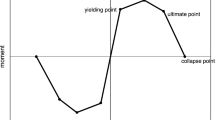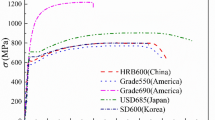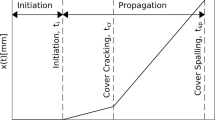Abstract
The hysteretic capacity of reinforced concrete (RC) structures depends to a large extent on the hysteretic behavior of steel bar to sustain many cycles of high plastic deformations without obvious degradation of strength and stiffness. It is important to develop an accurate and computationally efficient model of steel bar in the nonlinear response analysis of RC structures subjected to cyclic loads. The high strength and ultra-high-strength (UHS, yield strength above 1000 MPa) steel bars are becoming more and more popular in concrete construction, which is beneficial for materials saving and reduction of steel bar congestion. In order to investigate the cyclic behaviors of UHS steel bars and to propose a hysteretic model for this kind of steel bars including buckling, a total of 54 specimens with nine slenderness ratios were carried out under compressive and cyclic loadings. The modified stress–strain curve model of UHS steel bars with different slenderness ratio was developed based on the experimental data, which can take buckling and fatigue-induced reduction of stress into account. This study offers a solid database for researches on the mechanical properties of UHS steel bars. And the proposed empirical model can easily be implemented in the finite element analysis of RC elements with UHS steel bars under cyclic loadings.



















Similar content being viewed by others
References
Alaee P, Li B (2017a) High-strength concrete interior beam-column joints with high-yield strength steel reinforcements. J Struct Eng 143(7):1–12
Alaee P, Li B (2017b) High-strength concrete exterior beam-column joints with high-yield strength steel reinforcements. Eng Struct 145:305–321
Bai Y, Kawano A, Odawara K, Matsuo S (2012) Constitutive models for hollow steel tubes and concrete filled steel tubes considering the strength deterioration. J Struct Constr Eng 77:1141–1150
Balan TA, Filippou FC, Popov EP (1998) Hysteretic model of ordinary and high-strength reinforcing steel. J Struct Eng 124:288–297
Chang B, Hutchinson T, Wang X, Englekirk R (2014) Seismic performance of beam-column subassemblies with high-strength steel reinforcement. ACI Struct J 111(6):1329–1338
Chen X, Yan S, Ji B (2011) Pseudo-dynamic test and numerical simulation of high-strength concrete frame structure reinforced with high-strength rebars. Earthq Eng Eng Vib 10(2):303–311
Cosenza E, Prota A (2006) Experimental behavior and numerical modeling of smooth steel bars under compression. J Earthq Eng 10(19):313–329
Dhakal RP, Maekawa K (2002) Path-dependent cyclic stress–strain relationship of reinforcing bar including buckling. Eng Struct 24(11):1383–1396
Dodd L, Restrepo-Posada J (1995) Model for predicting cyclic behavior of reinforcing steel. J Struct Eng 121(3):433–445
Fernandez I, Bairán JM, Marí AR (2015) Corrosion effects on the mechanical properties of reinforcing steel bars. Fatigue and σ–ε behavior. Constr Build Mater 101:772–783
Filippou FC, Popov EP, Bertero VV (1983) Effects of bond deterioration on hysteretic behavior of reinforced concrete joints. Earthquake Engineering Research Center, Report UCB/EERC-83/19, University of California, Berkeley
GB/T228.1-2010 (2010) Metallic materials-Tensile testing-Part 1: Method of test at room temperature. Standards Press of China, Beijing
Gomes A, Appleton J (1997) Nonlinear cyclic stress–strain relationship of reinforcing bars including buckling. Eng Struct 19(10):822–826
Hill CD, Blandford GE, Wang ST (1989) Post-buckling analysis of steel space trusses. J Struct Eng 117(4):900–919
Ikeda K, Mahin SA, Dermitzakis SN (1984) Phenomenological modeling of steel braces under cyclic loading. Earthquake Engineering Research Center, College of Engineering, University of California, Berkeley
Kashani MM (2017) Size effect on inelastic buckling behavior of accelerated pitted corroded bars in porous media. J Mater Civ Eng 29(7):04017022
Kashani MM, Crewe AJ, Alexander NA (2013) Nonlinear cyclic response of corrosion-damaged reinforcing bars with the effect of buckling. Constr Build Mater 41:388–400
Kashani MM, Lowes LN, Crewe AJ, Alexander NA (2015) Phenomenological hysteretic model for corroded reinforcing bars including inelastic buckling and low-cycle fatigue degradation. Comput Struct 156:58–71
Kolwankar S, Kanvinde A, Kenawy M, Kunnath S (2017) Uniaxial nonlocal formulation for geometric nonlinearity-induced necking and buckling localization in a steel bar. J Struct Eng 143(9):04017091
Kolwankar S, Kanvinde A, Kenawy M, Lignos D, Kunnath S (2018) Simulating local buckling-induced softening in steel members using an equivalent nonlocal material model in displacement-based fiber elements. J Struct Eng 144(10):04018192
Kunnath SK, Heo Y, Mohle JF (2009) Nonlinear uniaxial material model for reinforcing steel bars. J Struct Eng 135(4):335–343
Lee JY, Choi SH, Lee DH (2016) Structural behaviour of reinforced concrete beams with high yield strength stirrups. Mag Concr Res 68(23):1187–1199
Mander JB, Priestley MJN, Park R (1984) Seismic design of bridge piers. In: Research report 84-2. Department of Civil Engineering, University of Canterbury, Christchurch (New Zealand)
Menegotto M (1973) Method of analysis for cyclically loaded RC plane frames including changes in geometry and non-elastic behavior of elements under combined normal force and bending. In: Proceedings of IABSE symposium on resistance and ultimate deformability of structures acted on by well defined repeated loads, pp 15–22
Monti G, Nuti C (1992) Nonlinear cyclic behavior of reinforcing bars including buckling. J Struct Eng 118(12):3268–3284
Moyer MJ, Kowalsky MJ (2003) Influence of tension strain on buckling of reinforcement in concrete columns. ACI Struct J 100(1):75–85
Nakamura H, Higai T (2002) Modeling of nonlinear cyclic behavior of reinforcing bars. Spec Publ 205:273–292
Prota A, Cicco F, Cosenza E (2009) Cyclic behavior of smooth steel reinforcing bars: experimental analysis and modeling issues. J Earthq Eng 13(4):500–519
Rodriguez ME, Botero JC, Villa J (1999) Cyclic stress–strain behavior of reinforcing steel including effect of buckling. J Struct Eng 125:605–612
Shahrooz BM, Reis JM, Wells EL, Miller RA, Harries KA, Russell HG (2013) Flexural members with high-strength reinforcement: behavior and code implications. J Bridge Eng 19(5):04014003
Suzuki Y, Lignos D (2018) Fiber-based model for earthquake-induced collapse simulation of steel frame buildings. In: Proceedings of the 11th US national conference on earthquake engineering
Thai HT, Kim SE (2011) Nonlinear inelastic time-history analysis of truss structures. J Constr Steel Res 67(12):1966–1972
Xiao X, Guan FL, Yan S (2008) Use of ultra-high-strength bars for seismic performance of rectangular high-strength concrete frame columns. Mag Concr Res 60(4):253–259
Yan S, Zhang LF, Zhang YG (2008) Seismic performances of high-strength concrete shear walls reinforced with high-strength rebars. In: Earth & space 2008: engineering, science, construction, and operations in challenging environments, pp 1–8
Zhu W, François R, Poon CS, Dai JG (2017) Influences of corrosion degree and corrosion morphology on the ductility of steel reinforcement. Constr Build Mater 148:297–306
Acknowledgements
This research is jointly funded by the National Key of Research and Development of China (2018YFC1504306), National Natural Science Foundation of China (NSFC) (Grants No. 51838010) and Beijing Municipal Education Commission (IDHT20190504). The results and conclusions presented in the paper are those of the authors and do not necessarily reflect the view of the sponsors.
Author information
Authors and Affiliations
Corresponding author
Ethics declarations
Conflict of interest
The authors declare that they have no conflict of interest.
Additional information
Publisher's Note
Springer Nature remains neutral with regard to jurisdictional claims in published maps and institutional affiliations.
Rights and permissions
About this article
Cite this article
Han, Q., Hu, M., Xu, K. et al. Hysteretic behavior and modelling of ultra-high-strength steel bar including buckling. Bull Earthquake Eng 17, 5265–5289 (2019). https://doi.org/10.1007/s10518-019-00675-4
Received:
Accepted:
Published:
Issue Date:
DOI: https://doi.org/10.1007/s10518-019-00675-4




